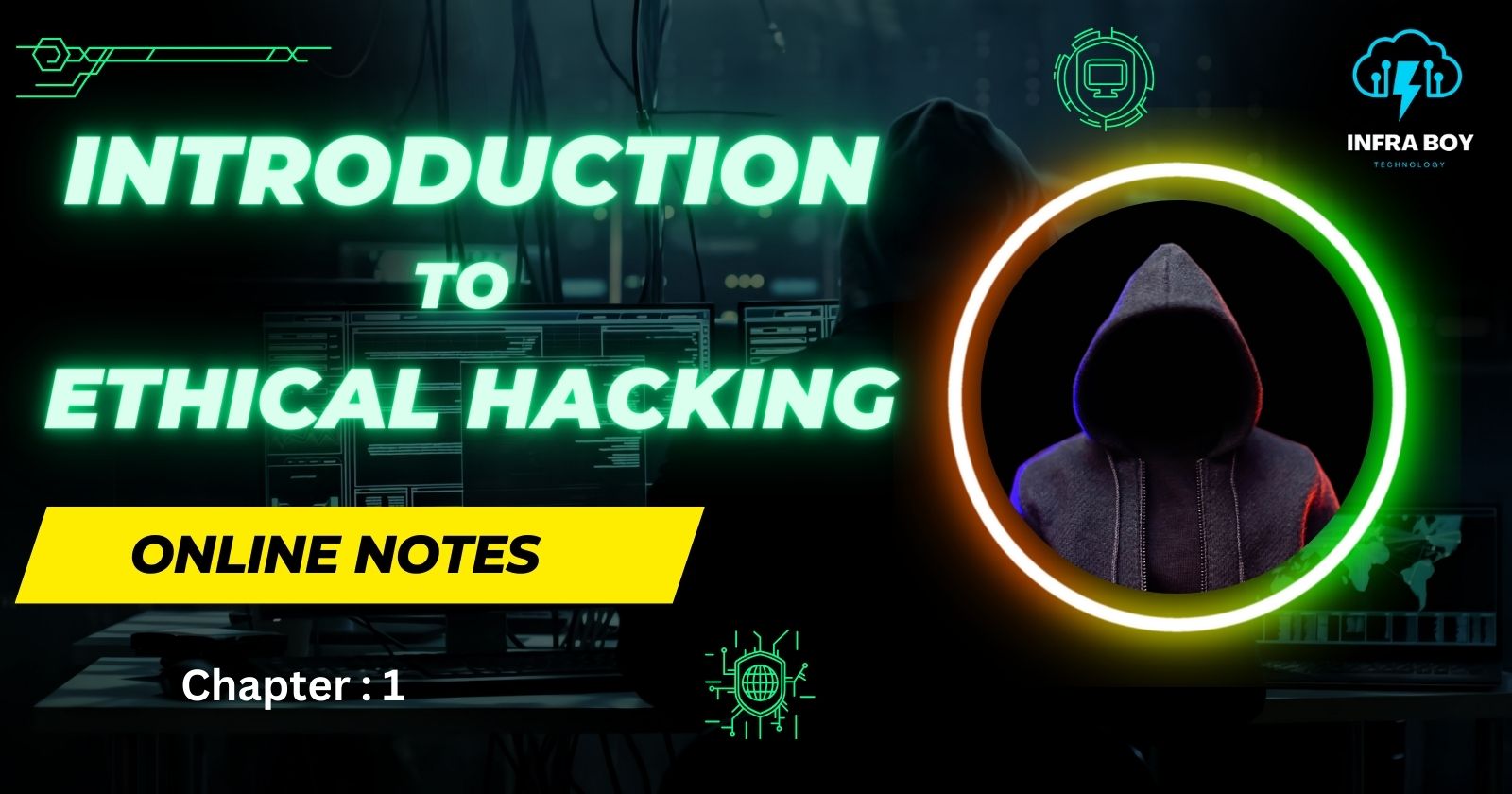Introduction to Ethical Hacking: Getting Started
 Infraboy
Infraboy
What is Hacking?
Hacking refers to the practice of exploiting weaknesses or vulnerabilities in computer systems, networks, or applications to gain unauthorized access, control, or information. While the term "hacking" often carries a negative connotation due to its association with cybercriminal activities, it encompasses a wide range of activities, including:
Black Hat Hacking: Illegal hacking performed with malicious intent, such as stealing data, spreading malware, or causing disruptions.
White Hat Hacking: Legal and ethical hacking conducted to improve security by identifying and fixing vulnerabilities.
Gray Hat Hacking: Activities that fall somewhere between black hat and white hat hacking. Gray hat hackers may exploit vulnerabilities without malicious intent but often without explicit permission.
Hacking techniques can include:
Phishing: Deceptive emails or messages designed to trick individuals into revealing sensitive information.
Malware: Malicious software such as viruses, worms, or ransomware used to compromise systems.
SQL Injection: A technique that exploits vulnerabilities in web applications to execute unauthorized SQL commands.
Brute Force Attack: A method that involves trying all possible combinations of passwords or encryption keys until the correct one is found.
What is Ethical Hacking?
Ethical Hacking involves legally and responsibly probing computer systems, networks, and applications to find security vulnerabilities that could be exploited by malicious hackers. Ethical hackers use the same tools and techniques as their malicious counterparts but with the organization's permission and with the goal of improving security.
Key aspects of ethical hacking include:
Permission: Ethical hackers always operate with explicit permission from the system owner.
Objective: The primary goal is to identify and fix security weaknesses before they can be exploited by malicious actors.
Scope: The scope of the hacking activities is defined and agreed upon beforehand to ensure no unintended damage is caused.
Reporting: Ethical hackers provide detailed reports of their findings, including potential vulnerabilities and recommendations for mitigation.
Who is an Ethical Hacker?
An Ethical Hacker is a professional who is skilled in identifying and addressing security vulnerabilities within computer systems, networks, and applications. Ethical hackers, also known as "white hat" hackers, play a crucial role in protecting organizations from cyber threats. They use their knowledge and skills to anticipate and counteract the tactics of malicious hackers.
Roles and Responsibilities of an Ethical Hacker:
Penetration Testing: Conducting simulated cyber attacks on systems to evaluate their security.
Vulnerability Assessment: Identifying, quantifying, and prioritizing security vulnerabilities in systems and networks.
Security Audits: Reviewing an organization's security policies, procedures, and controls to ensure they are effective and compliant with regulations.
Risk Assessment: Evaluating the potential impact of security threats on an organization's operations and assets.
Incident Response: Assisting in the investigation and mitigation of security breaches and incidents.
Training and Awareness: Educating employees and stakeholders about security best practices and the latest threat trends.
Skills and Qualifications:
Technical Knowledge: Proficiency in programming, networking, operating systems, and security tools.
Certifications: Credentials such as Certified Ethical Hacker (CEH), Offensive Security Certified Professional (OSCP), and Certified Information Systems Security Professional (CISSP).
Analytical Skills: The ability to analyze complex systems and identify potential weaknesses.
Problem-Solving: Creative and critical thinking to devise effective security solutions.
Communication Skills: The ability to clearly report findings and recommendations to technical and non-technical stakeholders.
CIA Triangle
The CIA Triangle is a fundamental model in information security that emphasizes three key principles:
Confidentiality: Ensuring that sensitive information is accessible only to those authorized to have access. Techniques to maintain confidentiality include encryption, access controls, and authentication mechanisms.
Integrity: Assuring that information is accurate and complete and that it has not been tampered with. Measures to protect integrity include hashing, checksums, and data validation.
Availability: Guaranteeing that information and resources are available to authorized users when needed. This involves maintaining reliable access through redundancy, fault tolerance, and regular maintenance.
Important Characteristics of Information Security
Authenticity: Verifying that users are who they claim to be and that each input arriving at the system came from a trusted source.
Non-repudiation: Ensuring that a sender cannot deny having sent a message and that a recipient cannot deny having received a message.
Accountability: Keeping track of user actions and ensuring users are responsible for their actions.
Security, Functionality, and Usability Triangle
This model highlights the trade-offs between three crucial aspects of system design:
Security: Measures to protect information and systems from threats.
Functionality: The features and capabilities provided by a system.
Usability: The ease with which users can interact with a system.
Enhancing security often impacts usability and functionality. For example, stronger authentication mechanisms can make systems more secure but might be cumbersome for users.
Phases of Hacking
Reconnaissance: Gathering information about the target using various techniques, such as social engineering, scanning, and open-source intelligence.
Scanning: Actively probing the target to identify open ports, services, and vulnerabilities using tools like Nmap.
Gaining Access: Exploiting identified vulnerabilities to gain unauthorized access to the target system.
Maintaining Access: Establishing a persistent presence in the system using backdoors, rootkits, or other methods.
Covering Tracks: Erasing evidence of the attack to avoid detection and ensure continued access.
Different Types of Attacks
Phishing: Fraudulent attempts to obtain sensitive information by masquerading as a trustworthy entity.
Denial of Service (DoS): Attacks aimed at making a system or network resource unavailable to users.
Man-in-the-Middle (MitM): Intercepting and altering communication between two parties without their knowledge.
SQL Injection: Injecting malicious SQL queries into input fields to manipulate databases.
Cross-Site Scripting (XSS): Injecting malicious scripts into webpages viewed by other users.
Vulnerability Assessment
A Vulnerability Assessment is a systematic review of security weaknesses in an information system. It includes:
Identification: Discovering vulnerabilities using automated tools and manual techniques.
Analysis: Evaluating the potential impact of discovered vulnerabilities.
Risk Assessment: Prioritizing vulnerabilities based on their potential threat and the importance of affected assets.
Reporting: Documenting findings and providing recommendations for remediation.
Penetration Testing
Penetration Testing, or Pen Testing, involves simulating cyberattacks to evaluate the security of a system. Steps include:
Planning and Reconnaissance: Defining the scope and objectives, and gathering information.
Scanning: Identifying vulnerabilities and open ports.
Exploitation: Attempting to exploit identified vulnerabilities to gain unauthorized access.
Post-Exploitation: Determining the impact of exploitation and attempting to maintain access.
Reporting: Documenting the findings, impact, and recommendations for improving security.
Subscribe to my newsletter
Read articles from Infraboy directly inside your inbox. Subscribe to the newsletter, and don't miss out.
Written by

Infraboy
Infraboy
We will provide all kinds of the note which is related to IT infra courses like : Networking , Cloud Computing , AWS , CEH , Cyber Security